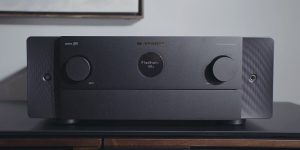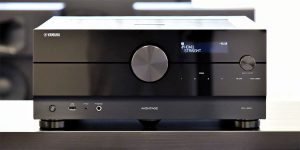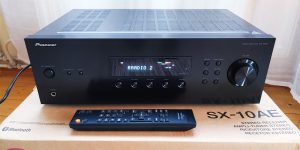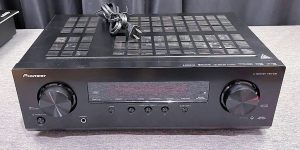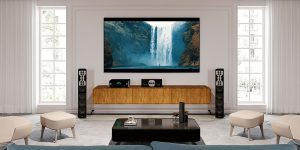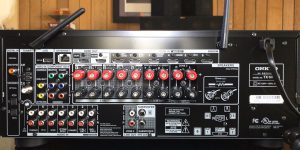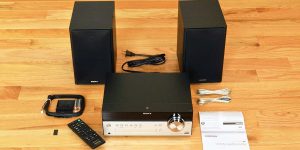If you already know a little about receivers, you understand their essential role in home theater. With such a device, you will want to use it throughout the house. The multi-room function with 2 or 3 zones will make this a reality. Many modern receivers are equipped with this function, but how to choose the best 3 zone receivers?
Previously, in order to equip a multimedia system for the whole house, it was necessary to provide for the placement of all the necessary cables. That certainly doesn’t decorate the interior and seriously complicates cleaning. But times have changed, and now, thanks to multi-room support, you can use speakers in several rooms and play different multimedia content in each zone.
Various companies are trying to meet the needs of users in different ways. Realizing this, I decided not to bet on any particular brand in today’s review. Instead, I chose 3 zone AV receivers from different manufacturers, which in my opinion, are really worth your attention.
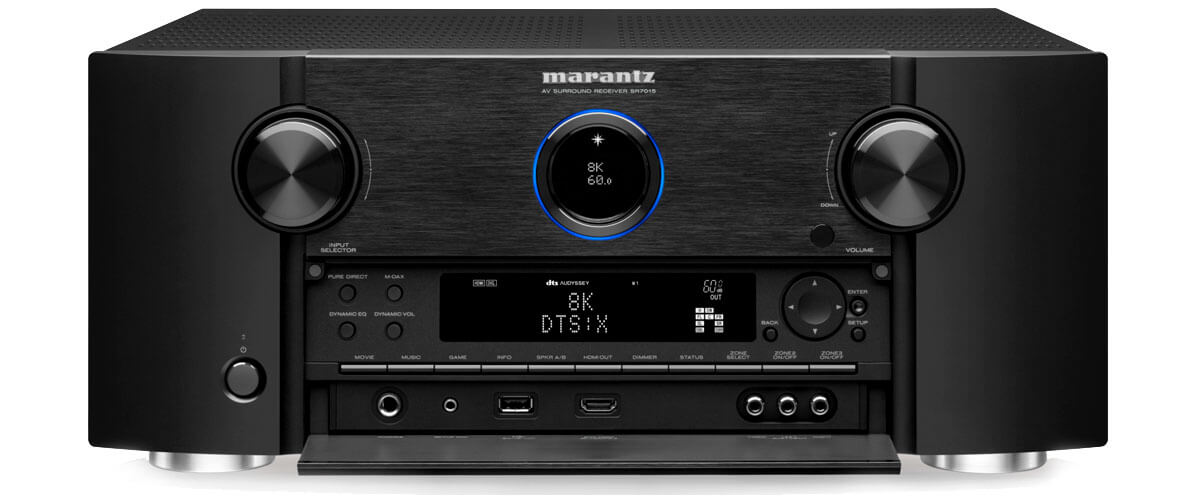
| Name | Channels | Power output | HDMI in/out | Bluetooth/Wi-Fi | Review |
|---|---|---|---|---|---|
| Marantz SR7015 best overall | 9.2 | 125W/8 Ohm, 165W/6 Ohm | 8/3 | yes/yes | Review |
| Onkyo TX-RZ50 budget | 9.2 | 120W/8 Ohm, 250W/6 Ohm | 7/2 | yes/yes | Review |
| Denon AVR-X4800H | 9.4 | 125W/8 Ohm, 165W/6 Ohm | 7/3 | yes/yes | Review |
| Yamaha RX-A6A | 9.2 | 150W/8 Ohm | 7/3 | yes/yes | Review |
Best 3 zone receiver reviews
| Table of content |
|---|
| Marantz SR7015 – best overall |
| Onkyo TX-RZ50 – budget |
| Denon AVR-X4800H |
| Yamaha RX-A6A |
Marantz SR7015 – best overall

First, I want to draw your attention to the SR7015 model. Marantz made it in 2020 and, since then, has managed to win the favor of many music and movie lovers. Its older brother is the 11-channel Marantz SR8015. Despite the relatively big price difference, the SR7015 doesn’t differ much from it.
The SR7015 has an intermediate design between the brand’s past and new generation of receivers. It already has a round LCD (which doesn’t show anything from afar) that allows you to recognize receivers anywhere, but it’s not yet as stylish as the CINEMA generation AVRs. The rather heavy weight of 31.3 pounds speaks to using quality internal components. Well, the model’s size is impressive, too; it will require space in your home theater. However, once you turn it around 180 degrees, you realize it’s necessary. The number of connections is enormous. And although Marantz has already removed the receiver from production, it is consistent with modern standards.
So, the receiver has a 9.2 channel amplifier with 125 watts per channel (8 ohms, 20Hz – 20kHz, 0.05% THD, 2ch Drive). In addition, the device is equipped with HDAM circuit boards and advanced 32-bit AKM AK4458 D/A converters for optimal playback accuracy and reduced distortion. I would also like to add that the model has been Roon Tested, thus ensuring maximum compatibility with other units.
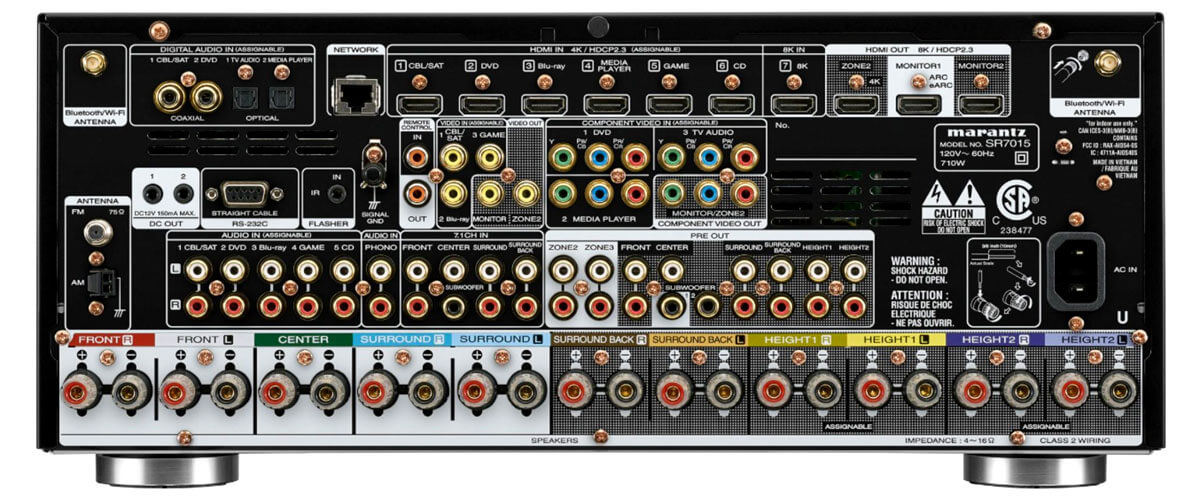
As for the quality of the picture, the SR8015 is fine with that. It supports enhanced gaming and new HDR formats such as HDR10+ and Dolby Vision. Thanks to the 8K resolution (60Hz), the movie is a pleasure to watch, as everything that happens looks clear and in moderate contrast. In short, the model confidently passed my test. The only thing you should pay attention to is that sometimes there is a problem with the 4K (120Hz) signal.
If you look at the specifications, the device has 7 HDMI back inputs (2.0) and 1 HDMI input (2.1) on the front panel with support for HDCP 2.3 and eARC. As for HDMI outputs, there are three units. Among the available connection methods are two subwoofer outputs, Wi-Fi, standard Ethernet, and Bluetooth.
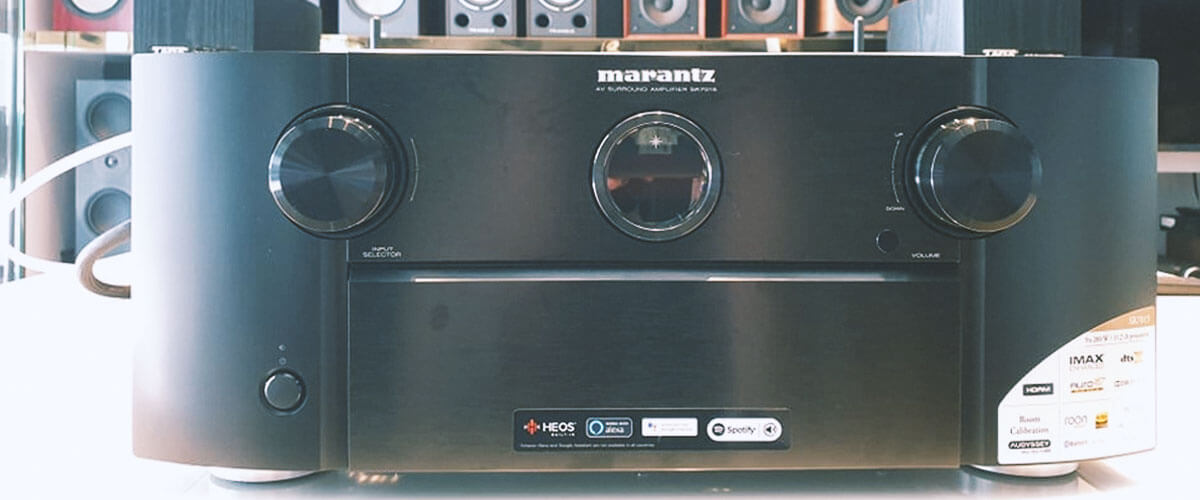
Now, I want to talk about the sound in more detail. The receiver supports various surround sound formats such as Auro 3D, Dolby Atmos, DTS:X, and IMAX Enhanced. After I calibrated the device with the Audyssey MultEQ XT32, the sound became much clearer, although it was at a good level before. The main soundstage has a great sense of height and width. Even though the SR7015 follows Marantz’s signature handwriting, this in no way prevents it from showing dynamic abilities and excellent acoustics. Testing the sound of this model was definitely an interesting experience.
The Denon AVR-X4800H is the only model that can really compete with the Marantz SR7015. Both devices are excellent variants with similar characteristics. But, in my opinion, the Marantz has a more solid sound than the AVR-X4800H.
Marantz SR7015 is the best AV receiver with 3 zones in my review. However, hurry up and buy it because the manufacturer has discontinued it. And it is its relevance and underpricing today that make it the most attractive purchase. You will get a 9.2-channel receiver of premium class (all its internal components can serve for decades without reducing the quality of work) for the price of a budget one (within the framework of this review). It has a huge number of connectors, supports 8K video (though only on one input), advanced surround sound formats (Auro 3D, Dolby Atmos, DTS:X, and IMAX Enhanced), and streaming services. It’s powerful and reliable, like a good home you want to pass down as an heirloom. And you can even hook up a separate amplifier and expand the system to an 11-channel system. The optimal combination of quality and value on my chart.
Key specs
- Channels: 9.2.
- Power output: 125W/8 Ohm, 165W/6 Ohm.
- HDMI inputs/outputs: 8/3.
- Video functions: 8K/60Hz, 4K/120Hz, 4K/60Hz pass-through, video upconversion (up to 1080p and 8K) for analog and HDMI sources.
- Bluetooth/Wi-Fi: yes/yes.
- Streaming services: AirPlay2, Deezer, Tidal, Pandora, SiriusXM, Napster, SoundCloud, Amazon Music, Amazon Music HD, Mood mix.
- Supports: HDMI ARC, HDMI eARC, HDMI CEC, HDCP2.3, HDR10, HDR10+, Dolby Vision.
- Surround sound: DTS HD Master, DTS Neural:X, Dolby TrueHD, Dolby Surround, Dolby Digital Plus, Dolby Atmos Height Virtualization, Dolby Atmos, Auro-3D, IMAX Enhanced, Multichannel stereo.
Pros
- High-performance discrete amplifier.
- 8K resolution.
- Roon Tested.
- Enhanced gaming.
- Full 3D Audio Support.
Cons
- Problem with 4K signal transmission.
- Only one input supports 8K.
Onkyo TX-RZ50 – budget
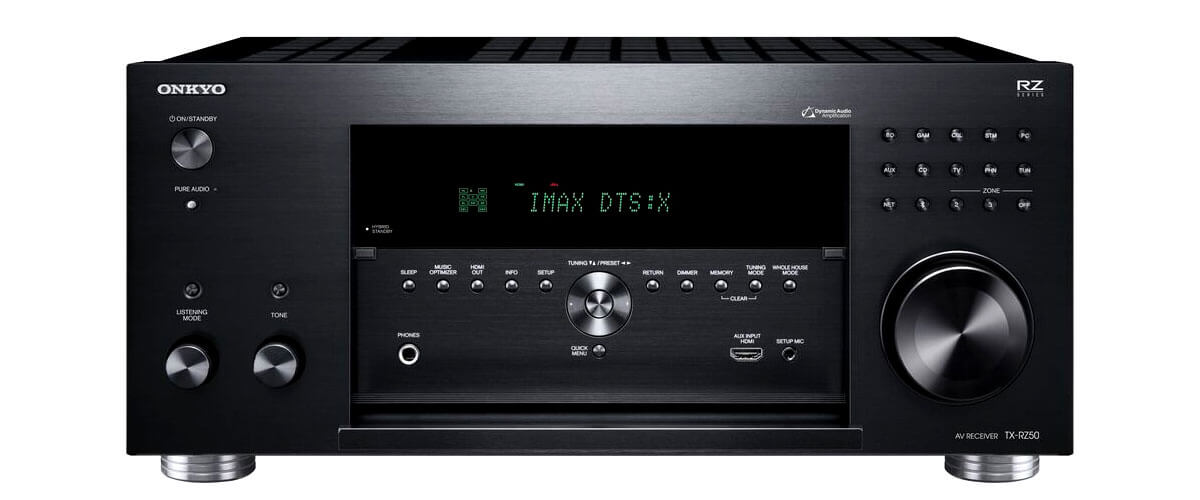
The Onkyo TX-RZ50 is next on my list. In 2021, it won the “product of the year” award, outperforming many competitors in its price niche. Despite being the cheapest receiver in my review, it definitely has much to show. The TX-RZ line also includes the TX-RZ1100 (2016), which is inferior in many ways.
Onkyo receivers are characterized by their straightforwardness and reliability. It is a kind of tank that can last a long time. But it’s not sleek, it’s not fancy, it’s quite ordinary. I’m not a fan of small buttons scattered all over the front panel. However, the main thing is not aesthetics; it is reliability. And although they are bound to get clogged with dust over time (but it depends on you, friends), it is pleasant to press them. They don’t lodge or dangle. And I love the huge bright LCD, which is rare among modern brands.
The Onkyo TX-RZ50 is equipped with a 9.2 channel amplifier with about 120 watts on each channel (8 ohms, 20Hz-20kHz, 0.08% THD, 2 channels driven). Furthermore, it has a built-in 1.8 GHz quad-core SoC, which allows it to perform multiple tasks simultaneously. In addition, the device is also certified as “Roon Tested.”
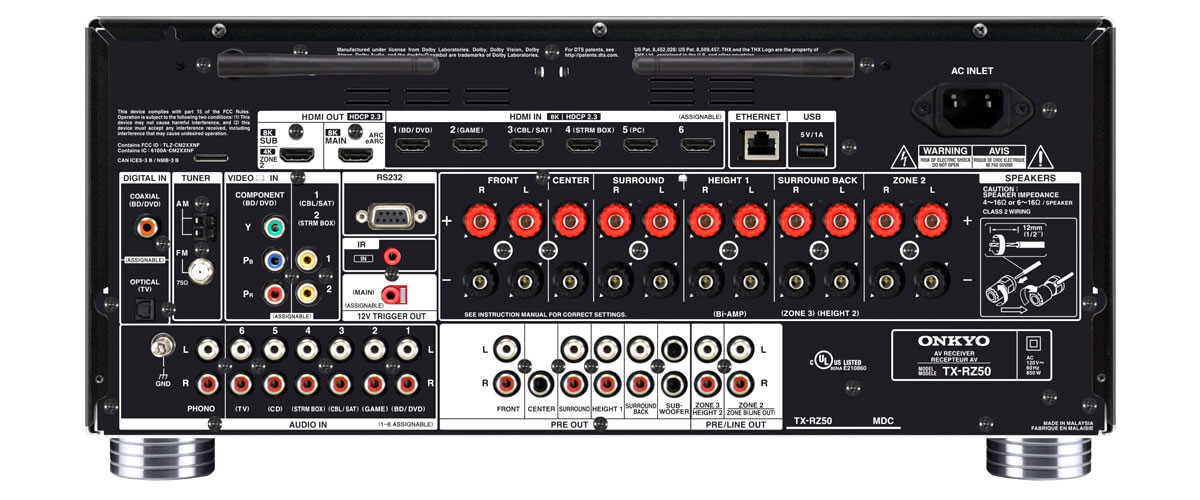
The TX-RZ50 delivers uncompressed HDMI 8K/4K transfer at 40 gigabits. The picture was not bad, but some things unpleasantly surprised me during the testing. First, the device is constantly turned on using the “TV” input. And if you want to switch to something else, you will encounter quite a long response time between switching sources. Second, the sound periodically disappeared during the test. So, I had to overload the receiver before it would begin to work correctly again.
This model has 6 HDMI inputs version 2.1 with HDCP 2.3 and eARC support, as well as 1 HDMI front input (2.0). As for 2 HDMI outputs (2.0), they are placed on the back. Available connectivity options include 2 subwoofer outputs, Wi-Fi (802.11ac), Bluetooth v4.2, and an Ethernet port.
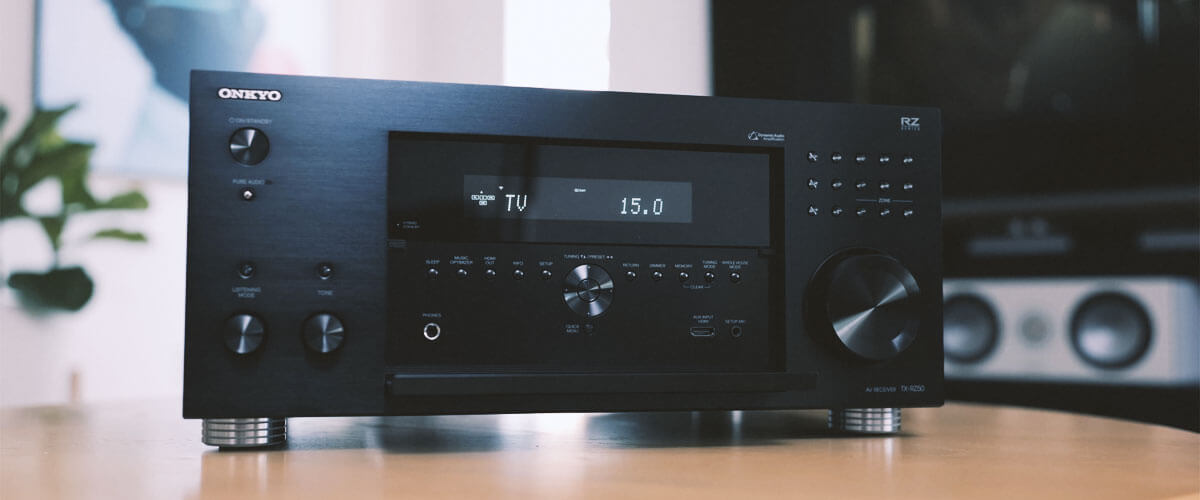
Now a little bit about the sound. If we approach this question from the technical side, Onkyo supports the latest surround sound formats and boasts Dirac live room correction and Klipsch optimize mode, allowing you to adjust the sound optimally. The whole procedure is quite clear and takes no more than an hour. Based on the data obtained, the types of all speakers, their distances, and levels will be set, as well as the correction curves, depending on the room’s characteristics and the speakers.
So what about its sound? The receiver plays audio and video content quite assertively. In my opinion, it lacks the entirety of the middle frequencies in some moments. As a result, you get a ton of dynamic bass and sharp detail, making your ears get tired quickly. But maybe it’s a matter of taste.
The Onkyo TX-RZ50 combines a low price with a huge number of features. This is the brand’s specialty: offering more for a nice budget. What does that mean? Some features will perform a little less well than in more expensive models. That’s the law. In this case, we have long switching between sources and difficulties with “missing” sound—rarely, but it happens. Also, the model does not support the popular advanced surround sound format Auro 3D.
Most importantly, against the background of the other reviewers, it does not stand out in sound. Denon and Marantz have a warm, realistic sound. Yamaha’s sound is crystalline and ringing. TX-RZ50 produces the usual strong sound but without zest. Anyway, the power and clarity of TX-RZ50 are quite enough. It is a good 9.2-channel receiver, which can be divided into 3 action zones.
Key specs
- Channels: 9.2.
- Power output: 120W/8 Ohm, 250W/6 Ohm.
- HDMI inputs/outputs: 7/2.
- Video functions: 8K/60Hz, 4K/120Hz, 4K/60Hz pass-through, video upconversion (up to 1080p and 8K) for analog and HDMI sources.
- Bluetooth/Wi-Fi: yes/yes.
- Streaming services: AirPlay2, Deezer, Tidal, Pandora, SiriusXM, Napster, SoundCloud, Amazon Music, Amazon Music HD, Mood mix.
- Supports: HDMI ARC, HDMI eARC, HDMI CEC, HDCP2.3, HDR10, HDR10+, Dolby Vision.
- Surround sound: DTS HD Master, DTS Neural:X, Dolby TrueHD, Dolby Surround, Dolby Digital Plus, Dolby Atmos Height Virtualization, Dolby Atmos, IMAX Enhanced
Pros
- 8K resolution.
- Roon Tested.
- The receiver has Sonos and THX certification.
- Dirac live room is available.
Cons
- No DTS Virtual:X and Auro 3D.
- Long response time while switching sources.
- Possible problems with sound loss.
Denon AVR-X4800H
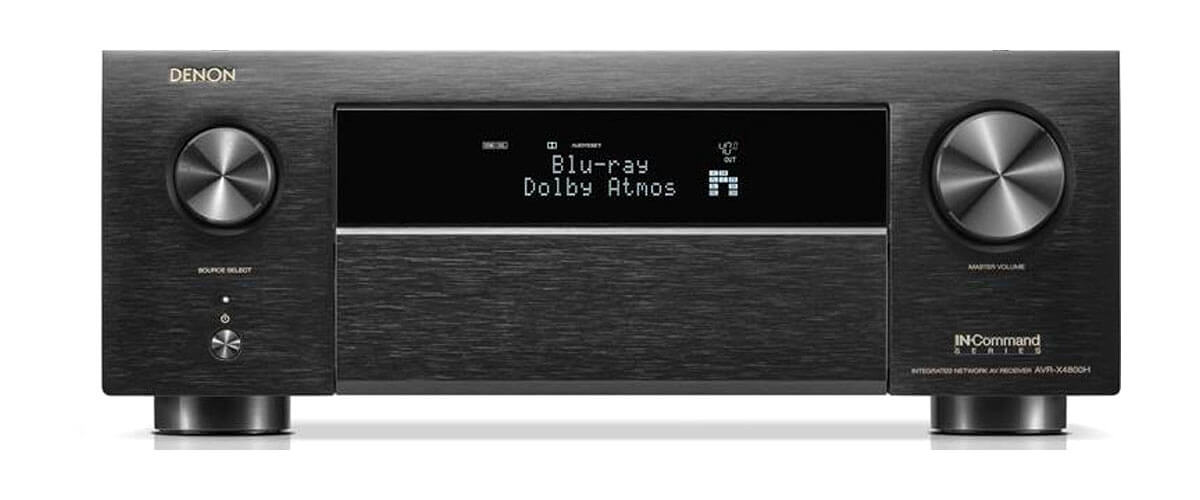
The penultimate device on my list is the Denon AVR-X4800H. The Japanese company released it in 2022. It is the most modern model on my list.
Since this is the main competitor of the leader of my review, Marantz SR7015, which has the same price but a slightly more modern set of options, there are also differences in their design. AVR-X4800H looks a bit simpler (Denon hasn’t changed the design of receivers for many years), but its LCD is quite large and bright. The control panel is hidden under a metal cover (like in SR7015), and the controls are smooth and precise. The weight and dimensions are slightly smaller, but you can connect as many as four subwoofers. This is because Denon’s standard is a sagging bass section, and the manufacturer compensates for this shortcoming.
The receiver has a 9.4-channel amplifier with 125 watts per channel (8 ohms, 20Hz-20kHz, THD: 0.05%, 2 ch. driven). I should note that it is equipped with technologies such as OvrC and Domotz Pro, allowing complete monitoring of installed electronic components and network support.
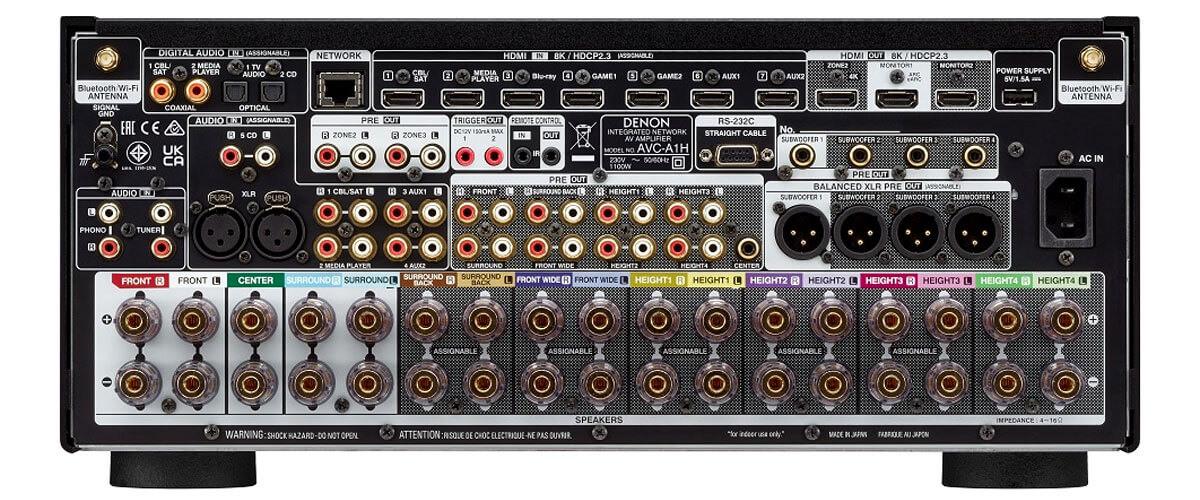
In terms of connectors and available connection methods, the receiver has 7 HDMI inputs version 2.1 and 3 HDMI outputs (2.0) with HDCP 2.3 and ARC/eARC support. You can connect to the device through four subwoofer outputs (independent), dual-band Wi-Fi (2.4GHz/5GHz), Ethernet ports, and Bluetooth.
The model works perfectly with 8K (60Hz) and 4K (120Hz) resolutions, supporting HDR, HLG, Dolby Vision, HDR10+, and Dynamic HDR. In addition, fans who play on consoles will be happy to see support for such technologies as VRR, ALLM, and QFT.
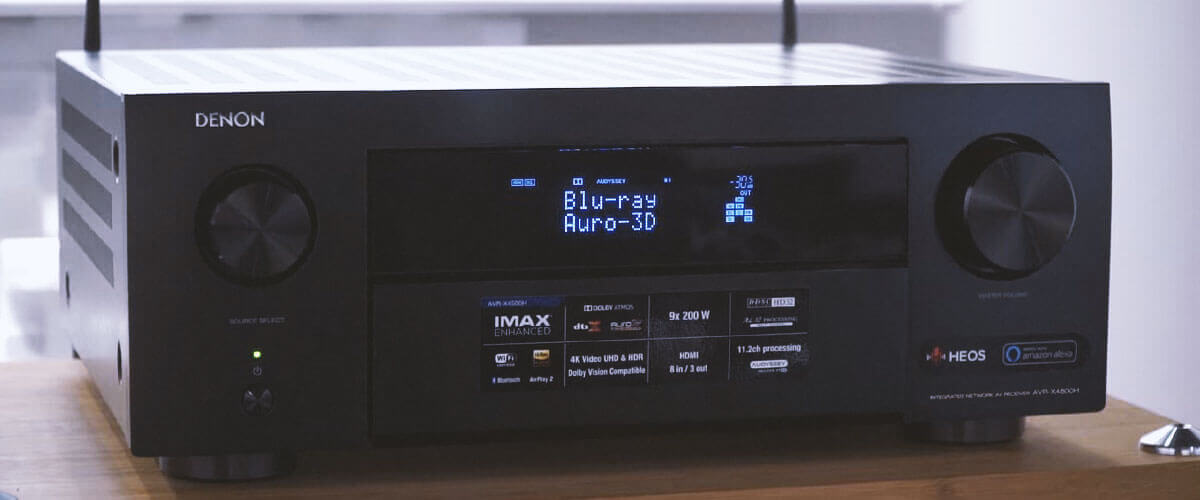
Due to the 9.4-channel surround sound, the unit boasts a deep stage and powerful bass that will fill a room in no time. The AVR-X4800H supports Dolby Atmos, DTS:X, Auro 3D, and IMAX Enhanced. The manufacturer also promises that it will be possible to adjust the sound with Dirac Live in the future.
For your modern home theater, the Denon AVR-X4800H is an excellent choice. This 3-zone receiver can expand your system to 11 channels with the addition of 4 subs. All its HDMI ports support 8K video, a feature not found in the Marantz SR7015. The wired and wireless signal is superb (except Bluetooth, but it’s not so important), perfect for your movies, music, and gaming needs. The receiver also supports the latest surround sound formats, just like the SR7015. So, why didn’t it become the leader?
It’s simple. I choose Marantz objectively when comparing it to Denon, which has the same price and feature set. It’s like comparing Mercedes and Volvo. There is nothing bad, but there is a difference. Still, the choice is yours alone.
Key specs
- Channels: 9.4.
- Power output: 125W/8 Ohm, 165W/6 Ohm.
- HDMI inputs/outputs: 7/3.
- Video functions: 8K/60Hz, 4K/120Hz, 4K/60Hz pass-through, video upconversion (up to 1080p and 8K) for analog and HDMI sources.
- Bluetooth/Wi-Fi: yes/yes.
- Streaming services: AirPlay2, Deezer, Tidal, Pandora, SiriusXM, Napster, SoundCloud, Amazon Music, Amazon Music HD, Mood mix.
- Supports: HDMI ARC, HDMI eARC, HDMI CEC, HDCP2.3, HDR10, HDR10+, Dolby Vision.
- Surround sound: DTS HD Master, DTS Neural:X, Dolby TrueHD, Dolby Surround, Dolby Digital Plus, Dolby Atmos Height Virtualization, Dolby Atmos, Auro-3D, IMAX Enhanced, Multichannel stereo.
Pros
- 8K pass-through.
- OvrC and Domotz Pro are present.
- Full 3D audio support.
- Four independent subwoofer outputs.
Cons
- Bad Bluetooth connection.
Yamaha RX-A6A
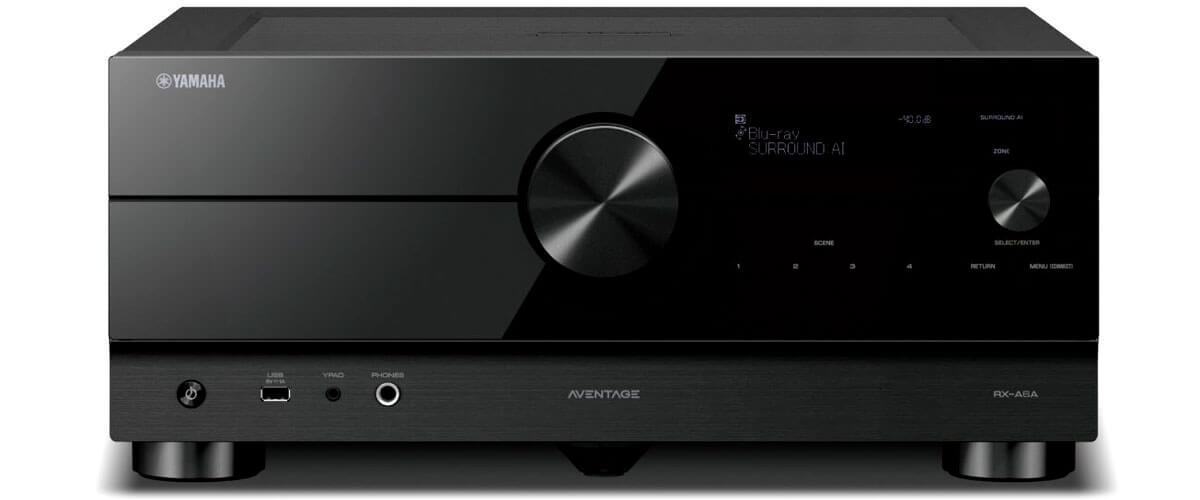
And the last model, which is worth paying attention to, is the RX-A6A. It was released in 2021 by the Yamaha company. This device belongs to the premium series, where the newer receiver is only the RX-A8A. Despite the completely different price tags, they have no critical differences.
Yamaha also builds very high-quality receivers from a structural (and beyond) standpoint. But the Aventage lineup, to which the RX-A6A belongs, makes me shudder. The glossy surface is very nice but attracts dust. Given the touch controls, it’s also terrible, and I used gloves during testing. Objectively, though, it is very beautiful. One more disadvantage for me is the small and hard-to-read display. Clearly, this design decision was made primarily to maintain the model’s minimalism, but I believe Yamaha could have come up with something better.
The device features a 9.2 channel amplifier with 150 watts on each channel (8 ohms, 20Hz – 20kHz, 0.06% THD, 2ch driven). In addition, it is equipped with a 32-bit SABRE PRO Premier ES9026PRO DAC for main channels and an ES9007S for height channels.
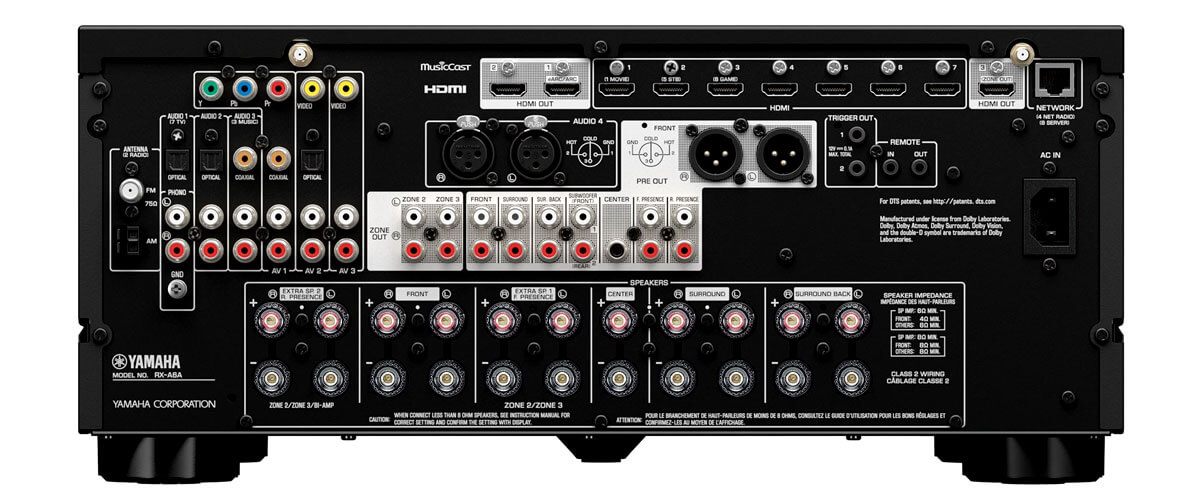
The RX-A6A delivers 4K (120Hz) and 8K (60Hz) resolution, supporting the latest HDR formats. The only thing that frustrates me is the speed of switching between different inputs. Switching receiver sources at this level should be much faster since users will have to do it often.
RX-A6A has 7 HDMI inputs (2.1) and 3 HDMI outputs (2.1) with HDCP 2.3 and eARC support. This 3-zone receiver has the main available connection methods include 2 subwoofer outputs, Bluetooth, a USB port, Wi-Fi, and Phono (MM) input.
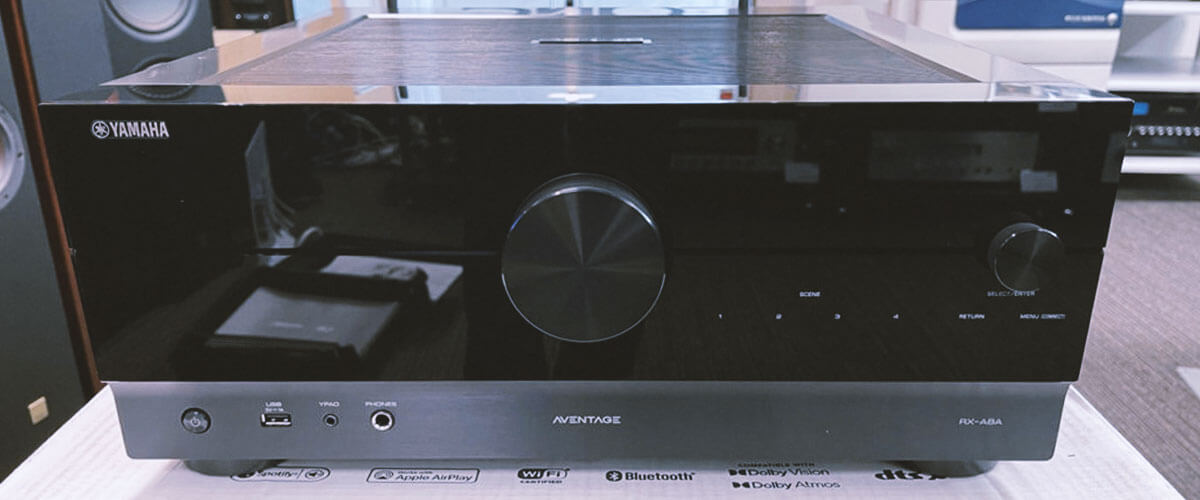
And finally, a bit about sound. Even though the sound has improved after calibrating through the YPAO-R.S.C, Yamaha’s competitors have long been using Dirac Live, which adjusts the sound much better. I would also like to say that I didn’t like the CINEMA DSP HD3 because the sound seemed too processed. But what about the two-channel mode or surround sound via Auro-3D and Dolby Atmos? It’s a whole other thing. The two-channel sound seemed calmer without adding the typical Yamaha warmth. In the second case, it is a clear and dynamic playback. No complaints. Everything is at a high level!
The Yamaha RX-A6A is a top 3-zone AVR that is very similar to the selection leader, the Marantz SR7015. It has 9.2 channels with 11-channel processing capability, 8K support (on all HDMI like the Denon AVR-X4800H), the same set of supported surround sound formats, and modern wireless options. In terms of power, it beats both predecessors because it delivers 150W with a purity worthy of a sophisticated viewer’s ears (THD 0.06%).
But it didn’t take the lead for several reasons. First, the design requires careful maintenance. Second, it has a specific cold sound (this is an objective judgment since the opinions of users are divided). But I’m sure no one will have any complaints about the signal transmission. Also, Yamaha’s calibration system is long overdue for improvement. Audyssey is much better, but it was at least possible to equip the RX-A6A with Dirac Live.
Key specs
- Channels: 9.2.
- Power output: 150W/8 Ohm.
- HDMI inputs/outputs: 7/3.
- Video functions: 8K/60Hz, 4K/120Hz, 4K/60Hz pass-through, video upconversion (up to 1080p and 8K) for analog and HDMI sources.
- Bluetooth/Wi-Fi: yes/yes.
- Streaming services: AirPlay2, Deezer, Tidal, Pandora, SiriusXM, Napster, SoundCloud, Amazon Music, Amazon Music HD, Mood mix.
- Supports: HDMI ARC, HDMI eARC, HDMI CEC, HDCP2.3, HDR10, HDR10+, Dolby Vision.
- Surround sound: DTS HD Master, DTS Neural:X, Dolby TrueHD, Dolby Surround, Dolby Digital Plus, Dolby Atmos Height Virtualization, Dolby Atmos, Auro-3D
Pros
- Powerful amplifier.
- 8K pass-through.
- Full 3D Audio support.
- Phono (MM) input.
Cons
- Small and poorly readable display.
- The slow switching speed between sources.
- No Dirac Live, and the native calibration system is inferior to Audyssey at Marantz and Denon.
FAQ
What is a multi-zone feature?
How many channels do I need for 3-zone audio?
Can I use two zones in the same room?
We are supported by our audience. When you purchase through links on our site, we may earn an affiliate commission at no extra cost to you.
Our newsletter
* We will never send you spam or share your email with third parties

![Best Budget Receivers [Reviewed and Tested]](https://thetechholics.com/wp-content/uploads/2023/10/best-budget-av-receiver-300x150.jpg)
![Best 9-Channels AV Receivers [Reviewed and Tested]](https://thetechholics.com/wp-content/uploads/2023/10/best-9-2-receiver-300x150.jpg)
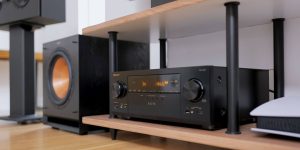
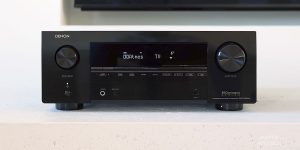
![Pioneer vs Denon Receivers [Top Models Compared and Tested]](https://thetechholics.com/wp-content/uploads/2023/10/denon-vs-pioneer-review-300x150.jpg)
